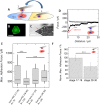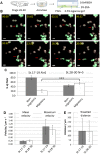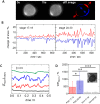Migratory and adhesive properties of Xenopus laevis primordial germ cells in vitro
- PMID: 24285703
- PMCID: PMC3863412
- DOI: 10.1242/bio.20135140
Migratory and adhesive properties of Xenopus laevis primordial germ cells in vitro
Abstract
The directional migration of primordial germ cells (PGCs) to the site of gonad formation is an advantageous model system to study cell motility. The embryonic development of PGCs has been investigated in different animal species, including mice, zebrafish, Xenopus and Drosophila. In this study we focus on the physical properties of Xenopus laevis PGCs during their transition from the passive to the active migratory state. Pre-migratory PGCs from Xenopus laevis embryos at developmental stages 17-19 to be compared with migratory PGCs from stages 28-30 were isolated and characterized in respect to motility and adhesive properties. Using single-cell force spectroscopy, we observed a decline in adhesiveness of PGCs upon reaching the migratory state, as defined by decreased attachment to extracellular matrix components like fibronectin, and a reduced adhesion to somatic endodermal cells. Data obtained from qPCR analysis with isolated PGCs reveal that down-regulation of E-cadherin might contribute to this weakening of cell-cell adhesion. Interestingly, however, using an in vitro migration assay, we found that movement of X. laevis PGCs can also occur independently of specific interactions with their neighboring cells. The reduction of cellular adhesion during PGC development is accompanied by enhanced cellular motility, as reflected in increased formation of bleb-like protrusions and inferred from electric cell-substrate impedance sensing (ECIS) as well as time-lapse image analysis. Temporal alterations in cell shape, including contraction and expansion of the cellular body, reveal a higher degree of cellular dynamics for the migratory PGCs in vitro.
Keywords: Cell adhesion; Cell migration; Cellular dynamics; Primordial germ cells; Xenopus.
Conflict of interest statement
Figures





Similar articles
-
Developmental regulation of locomotive activity in Xenopus primordial germ cells.Dev Growth Differ. 2013 Feb;55(2):217-28. doi: 10.1111/dgd.12018. Epub 2012 Dec 20. Dev Growth Differ. 2013. PMID: 23278717
-
Reduction in E-cadherin expression fosters migration of Xenopus laevis primordial germ cells.Integr Biol (Camb). 2016 Mar 14;8(3):349-58. doi: 10.1039/c5ib00291e. Integr Biol (Camb). 2016. PMID: 26907205
-
Primordial germ cells of Xenopus embryos: the role of fibronectin in their adhesion during migration.Cell. 1981 Dec;27(3 Pt 2):437-47. doi: 10.1016/0092-8674(81)90385-8. Cell. 1981. PMID: 6101198
-
Regulation of primordial germ cell development in the mouse.Int J Dev Biol. 2000;44(6):575-80. Int J Dev Biol. 2000. PMID: 11061420 Review.
-
Zebrafish Primordial Germ Cell Migration.Front Cell Dev Biol. 2021 Jun 23;9:684460. doi: 10.3389/fcell.2021.684460. eCollection 2021. Front Cell Dev Biol. 2021. PMID: 34249937 Free PMC article. Review.
Cited by
-
The Xenopus Maternal-to-Zygotic Transition from the Perspective of the Germline.Curr Top Dev Biol. 2015;113:271-303. doi: 10.1016/bs.ctdb.2015.07.021. Epub 2015 Aug 21. Curr Top Dev Biol. 2015. PMID: 26358876 Free PMC article. Review.
-
Epithelial cells sacrifice excess area to preserve fluidity in response to external mechanical stress.Commun Biol. 2022 Aug 22;5(1):855. doi: 10.1038/s42003-022-03809-8. Commun Biol. 2022. PMID: 35995827 Free PMC article.
-
Myosin II-interacting guanine nucleotide exchange factor promotes bleb retraction via stimulating cortex reassembly at the bleb membrane.Mol Biol Cell. 2018 Mar 1;29(5):643-656. doi: 10.1091/mbc.E17-10-0579. Epub 2018 Jan 10. Mol Biol Cell. 2018. PMID: 29321250 Free PMC article.
-
Pregametogenesis: The Earliest Stages of Gonad and Germline Differentiation in Anuran Amphibians.Biology (Basel). 2024 Dec 5;13(12):1017. doi: 10.3390/biology13121017. Biology (Basel). 2024. PMID: 39765684 Free PMC article. Review.
-
The journey of a generation: advances and promises in the study of primordial germ cell migration.Development. 2024 Apr 1;151(7):dev201102. doi: 10.1242/dev.201102. Epub 2024 Apr 12. Development. 2024. PMID: 38607588 Free PMC article.
References
-
- Berekelia L. A., Ponomarev M. B., Mikriukov A. A., Luchinskaia N. N., BeliavskiǏ A. V. (2005). [Molecular mechanisms of germ cell line determination in animals]. Mol. Biol. (Mosk.) 39, 664–677. - PubMed
LinkOut - more resources
Full Text Sources
Other Literature Sources

